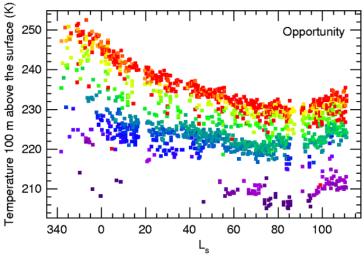
|
Seasonal Air Temperatures Above Opportunity
- Click the image above for a larger view
- Full-Res JPEG (794 x 559) (76.9 kB)
- Full-Res TIFF (794 x 559) (205.1 kB)
Caption:
This graph shows the seasonal trend of air temperatures 100 meters (328 feet) above NASA's Mars Exploration Rover Opportunity from late summer (left) to mid-winter (right) of Mars' southern hemisphere. The temperatures were measured with the rover's miniature thermal emission spectrometer. The colors represent different times of day: purple for early morning, green for midday, red for late afternoon. The measured temperatures range from about 200 Kelvin (minus 100 Fahrenheit) to 250 Kelvin (minus 10 Fahrenheit). The units of time along the horizontal axis are given in longitude of the Sun (Ls) as measured in a Mars-centered coordinate system, a way to reflect the elliptical nature of Mars' orbit. On this scale, Mars is farthest from the Sun at about 74, which also corresponds to late fall in the southern hemisphere.
The same cooling trend as seen for the 100-meter height in this graph also has been measured for higher regions of the atmosphere. In particular, the changes at 5 to 10 kilometers (3 to 6 miles) high are such that water-ice clouds will form when Mars is farthest from the Sun. At other parts of the Mars year, if clouds form at all, they will be found generally above 25 kilometers (16 miles), where there is significantly less water vapor.
Cataloging Keywords:
| Name | Value | Additional Values |
|---|---|---|
| Target | Mars | |
| System | ||
| Target Type | Planet | |
| Mission | Mars Exploration Rover (MER) | |
| Instrument Host | Opportunity (MER-B) | |
| Host Type | Rover | |
| Instrument | Miniature Thermal Emission Spectrometer (Mini-TES) | |
| Detector | ||
| Extra Keywords | Atmosphere, Color, Thermal, Water | |
| Acquisition Date | ||
| Release Date | 2004-12-13 | |
| Date in Caption | ||
| Image Credit | NASA/JPL/Cornell/ASU/SSI | |
| Source | photojournal.jpl.nasa.gov/catalog/PIA07103 | |
| Identifier | PIA07103 | |
